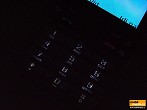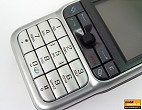Nokia 3230 review: Smartphone for the masses
A rounded cuboid
When I saw the phone in the first official pictures it seemed to me smaller than it is in reality. Anyway, its dimensions - 109 × 49 × 19 mm - are not big at all. As far as the weight is concerned (110 g), however, I was not that satisfied. I just find the phone unnecessarily too heavy. Perhaps that is the tax, which is to be paid for having an excellent construction. Even if that is the case, for this phone I am willing to pay it.



I just can't help comparing...
On the bottom of the phone is the standard Pop-Port connector. In it you can plug a data cable as well as the Nokia Stereo Headset HDS-3 earphones, which are delivered together with the telephone. Next to it is the outlet for the charger.
Display: pure quality
Nokia 3230 does not offer innovations in the display - just like with the previous phones of the class Series 60. A resolution of 176 × 208 pixels and 65 536 colors are features we are already used to. The backlighting is evenly distributed all over the viewing area. However, it is notably brighter compared to the backlighting of Nokia 7610, for example.
The brightness intensity can be changed within the general options of the display settings. I find the jumps between the intensity levels unnecessarily big though. The three lowest setting modes make the display go out completely. In the same menu you can setup the screensaver. There are two standard screensavers to choose of: Date and Time or Text.



The backlighting intensity is really high
Nokia 3230 takes in an option for graphic themes changing. The theme wraps up the whole phone including the icons and the menus into a different design. When delivered the phone is equipped with four pre-installed graphic themes.
The keypad: it is tough here
Whereas I extolled the display, the keypad brought the moment of disappointment. Before you master writing with one hand only you will have to first learn how to hold the phone. The keys may be lifted enough above the surface, but they are located much too low, which makes the pressing possible, only provided you bend your thumb considerably. Moreover, the numeric keypad is a bit rigid and it requires quite an effort to handle.
If I claim not to be satisfied with the numeric keypad, then I am twice as much unsatisfied with the functional buttons placed close below the display. The reaction of the buttons for accepting and refusing a call is good, but the rest of the buttons are much too rigid. Every press is accompanied by an audible click. The two functional buttons located below the display serve for setting the start of the program desired.
The main control element of Nokia 3230 is the five-way joystick placed in the middle of the functional buttons. Although I am more of a fan of the direction buttons rather than the joysticks, the 3230 model's joystick was a pleasant surprise. It is easy to control and works very exactly. When the phone is in a stand-by mode, four actions are steadily attached to the five ways of the joystick. A move to the left starts the writing of a text message; a move to the right opens the built-in calendar. A move upwards opens the Photo-Video application and a press or a move downwards takes you to the address book.
The backlighting is also excellent. It is evenly distributed among all keys and you will hardly find an area, where it is notably brighter.



The keypad backlighting is really good
You can use other two special buttons, in addition to the standard control keys. The switch on/off button and the button for work with ring profiles are traditionally placed on the bottom side of the phone. The latter one is quite rigid, as well. As for the left side of the phone, here you will find the button, which starts the Push to talk function.
Memory: is it enough?
The phone has 6 MB internal storage memory . Even though it is not that little, the other Symbian phones have already made us get used to higher values. Along with the built-in memory the phone also comes with a 32MB memory card. Nokia 3230 uses a memory card of the RS DV MMC type (Reduced Size Dual Voltage MultiMediaCard).
It is generally known that the operational system Symbian is not one of the fastest on the market. The reaction of the keys of the 3230 model after having been pressed is not immediate either. Once again I have the opportunity to compare with Nokia 7610. The new phone seems to be slightly quicker. Its advantage is most notable when starting any of the installed applications. This does not hold true for picture saving though. Saving a picture in a mega pixel resolution takes the phone approximately 5 seconds, which is a relatively long time.
When running a program the phone uses storage memory (RAM). Even though the manufacturer does not give any exact values, according to the AppMan application the RAM is about 9 MB. However, when tested by the JBenchmark application, Nokia 3230 did not perform as well as one might have expected. It gained 2561 points in the 1.0 version, which is somewhere between the performance given by Nokia 6600 and Nokia 7610. It is worth pointing out that during the tests the phone did not jam even once, except for the already mentioned moment, when the memory card was removed. We will have to wait for the final version of the phone though, because the firmware of the one tested still has some smaller drawbacks. In some way or other, Nokia has definitely taken the right direction.
SettingWizard: a no time set up
The SettingWizard program has been slowly becoming a standard part of the equipment of all modern mobile phones. It enables for simplified setting of data transfers, multimedia messages or emails. It is an application, which automatically selects the type of setting according to the operator. Unlike Nokia 6630, in which smaller complications would sometimes occur, no problems arose when setting Nokia 3230. It took me about 10 seconds to start using GPRS, MMS and e-mail through T-Mobile service.
Reader comments
- Anonymous
- 26 Mar 2024
- D7T
Does it support 4g?
- Biswajit76
- 03 Nov 2018
- PEW
Once upon a time I had use it. It was very good phone 3230.
- mic
- 18 Apr 2018
- IW@
Just factory reset the phone. I don't know if it works in this model; Press the "3", "Asterisk", "end key" and "the power button" BEFORE the phone says "NOKIA". But this will wipe your PHONE MEMORY. I recommend to put your stuff onto the memory card...


















